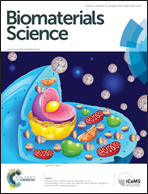Cellular uptake of drug loaded spider silk particles†
Abstract
Medical therapies are often accompanied by un-wanted side-effects or, even worse, targeted cells can develop drug resistance leading to an ineffective treatment. Therefore, drug delivery systems are under investigation to lower the risk thereof. Drug carriers should be biocompatible, biodegradable, nontoxic, non-immunogenic, and should show controllable drug loading and release properties. Previous studies qualified spider silk particles as drug delivery carriers, however, cellular uptake was only tested with unloaded spider silk particles. Here, the effect of drug loading on cellular uptake of previously established spider silk-based particles made of eADF4(C16), eADF4(C16)RGD, eADF4(C16)R8G and eADF4(κ16) was investigated. Fluorescently labelled polyethylenimine was used as a model substance for loading eADF4(C16), eADF4(C16)RGD or eADF4(C16)R8G particles, and fluorescently labelled ssDNA was used for loading eADF4(κ16) particles. Upon loading polyanionic eADF4(C16) and eADF4(C16)RGD particles with polycationic polyethylenimine the cellular uptake efficiency was increased, while the uptake of eADF4(C16)R8G and polycationic eADF4(κ16) particles was decreased upon substance loading. The latter could be circumvented by coating substance-loaded eADF4(κ16) particles with an additional layer of eADF4(κ16) (layer-by-layer coating). Further, it could be shown that eADF4(C16)RGD and eADF4(κ16) uptake was based on clathrin-mediated endocytosis, whereas macropinocytosis was more important in case of eADF4(C16) and eADF4(C16)R8G particle uptake. Finally, it was confirmed that drugs, such as doxorubicin, can be efficiently delivered into and released within cells when spider silk particles were used as a carrier.


 Please wait while we load your content...
Please wait while we load your content...